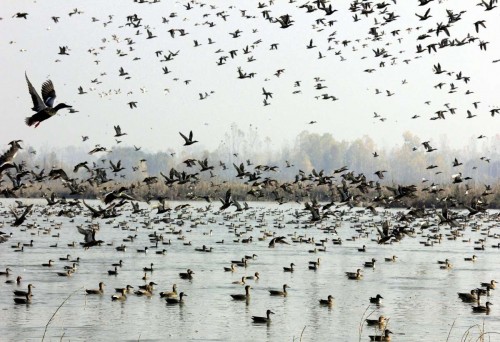
By Sheikh Qayoom
Over 300,000 migratory birds have kept their tryst with Kashmir this year, despite recent unprecedented floods damaging their winter home. The avian visitors have flown into their wetland reserve in Kashmir as every year and more are expected in the coming days.
“There are 300,000 migratory birds including Greylag geese, common teals, mallards, crested pochards, gadwalls and coots in this wetland reserve this time,” Imtiyaz Ahmad Lone, wildlife warden (Wetlands) Kashmir, said here.
Lone said the recent floods have severely damaged the eco-system of this wetland reserve and they are assessing the impact of this damage on the avian visitors this season.
“Floods inundated Hokarsar and all other wetland reserves of the Valley this year. Silt and solid waste have been left behind by the flood waters in Hokarsar, Shallabugh, Hygam and Mirgund bird reserves.
“This has seriously damaged the flora and fauna in these water bodies. We are assessing the effect of this damage on the migratory birds. But, thankfully, there are no reports of any sick birds like those suffering from bird flu anywhere in the Valley,” the warden said.
In September, Jammu and Kashmir faced its worst floods in half a century.
Despite a staff crunch, Lone and his team are doing their best to ensure that the winter homes of the migratory birds are back to their old glory.
What is bothering the wildlife warden is the oily layer that was found on the water body in Hokarsar a few days back.
“This is a disturbing development and we are keeping a close watch on this,” he said.
Thousands of such avian visitors throng the wetland reserves of the Valley each year, coming here to ward off the extreme winter cold of their summer homes in Russian Siberia, the Philippines, Eastern Europe, China and central Asia where water bodies freeze rock solid in winter months.
Lone said other major wetland reserves like Shallabugh, Hygam and Mirgund are yet to host migratory birds because the water level is very low there due to breaches caused by the recent floods.
“We are plugging the breaches to raise the water level in Shallabugh and in another two to three days the process would be completed so that the reserve can host the avian visitors.
“Hygam wetland reserve also faces the same problem. We had expected the Wullar Development Authority to start restoration works there, but this has not been done so far,” Lone admitted.
Another development is that birds of passage like the cormorants that come to spend a few days in the Valley’s wetland reserves before migrating to the plains of Punjab and other places in the country have not been spotted so far.
“We have not spotted any birds of passage this year so far in Hokarsar,” Lone said.
Poaching of migratory birds has been a major problem in Kashmir although under the state’s wildlife protection laws, bird shooting inside or outside the reserves here is banned.
Despite the ban order, migratory birds are usually sold on the sly at many places in the Valley.
“We seize guns of poachers and also book them under the wildlife protection laws. Poaching has come down remarkably because of the stringent bird protection laws.
“Yes, I do not deny some poaching might take place in areas outside the bird reserves, especially in the areas around the Wullar Lake,” Lone said.
The birds spend their daytime inside the safety of the bird reserves in the Valley.
For night feeding, the birds flock out to the Wullar Lake and other water bodies where poachers take pot shots at them.